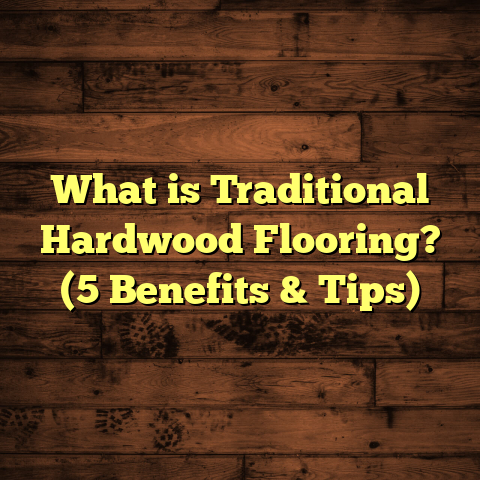What is Hand Scraped Vinyl Flooring? (5 Reasons to Choose It!)
Tech innovations have changed the way we live, work, and even how our homes look. Flooring, in particular, has seen a massive shift thanks to new materials and manufacturing techniques. One product that stands out in my experience is hand scraped vinyl flooring. When I first encountered this style, I was fascinated by how it blended the warm, rustic charm of hand scraped hardwood with the practical benefits of vinyl. Over time, I’ve installed it in many homes and commercial spaces, learning a lot about its pros and cons along the way. If you’re wondering what hand scraped vinyl flooring is and whether it’s right for your space, let me take you through everything you need to know. I’ll share tips, insights, data, and some stories from my projects to help you decide confidently.
What is Hand Scraped Vinyl Flooring?
Hand scraped vinyl flooring is a type of luxury vinyl flooring designed to replicate the look and feel of hand scraped hardwood floors. To understand this better, picture genuine hand scraped wood—a floor where each plank has slight dents, grooves, and uneven textures created by craftsmen scraping the surface by hand. These imperfections give the wood character and warmth that smooth or polished floors often lack.
The idea behind hand scraped vinyl is to capture that exact aesthetic but with vinyl—a synthetic material made mostly from polyvinyl chloride (PVC). The process involves printing high-quality images of wood grains onto vinyl planks or sheets. Then, advanced embossing techniques press textured patterns onto the surface to mimic the hand scraped wood’s roughness and depth.
This combination creates a floor that looks incredibly authentic but carries all of vinyl’s well-known benefits like water resistance, durability, and low maintenance.
How Hand Scraped Vinyl Flooring Compares to Other Flooring Types
To put it in perspective:
- Hardwood floors are natural, beautiful, and can be refinished multiple times but are expensive and prone to scratches and water damage.
- Laminate floors mimic wood using a photographic layer but often lack texture and can’t handle moisture well.
- Standard vinyl is affordable and water-resistant but usually comes with smooth surfaces lacking the natural wood feel.
- Hand scraped vinyl offers a middle ground—great looks with practical features.
The Manufacturing Process
Here’s a bit of behind-the-scenes from my visits to flooring factories:
- Design: High-resolution images of different wood species are captured.
- Printing: These images are printed on vinyl layers with exceptional detail.
- Embossing: Using heated rollers or plates, textures are pressed into the vinyl surface. This step creates grooves and dents that replicate hand scraping.
- Protective Coating: A durable top layer protects the floor from wear and tear.
- Cutting: The vinyl is cut into planks or tiles ready for installation.
Each plank tries to look unique, just like real wood, with no two pieces being exactly alike.
Why Does Hand Scraped Vinyl Flooring Matter?
You might ask: why should I care about hand scraped vinyl over regular vinyl or hardwood? Well, from my experience working on various projects, this flooring style hits a sweet spot between aesthetics and functionality.
I’ve had clients who loved hardwood floors but lived in humid regions where wood warped quickly. Others wanted the rustic look for their cabins but needed something easier to clean than real wood. Hand scraped vinyl answered these challenges beautifully.
Plus, it appeals to people who want a natural feel without spending as much or worrying about long-term upkeep.
5 Reasons I Choose Hand Scraped Vinyl Flooring for My Projects
1. Realistic Texture That Hides Wear and Tear
One major win for this flooring is how well it masks scratches and dents. The uneven surface catches light differently across each groove, making minor damage less noticeable.
Did you know? According to a National Wood Flooring Association report, homes with textured floors show 30% less visible wear compared to smooth finishes after five years.
From personal experience, in homes with kids or pets, this texture prevents little scratches from ruining the overall look fast. A client once told me their dog’s nails left barely any marks after months of running around on their new hand scraped vinyl floors.
2. Water Resistance Suited for Busy Areas
Vinyl floors are known for being water-resistant or waterproof depending on the product. This makes them ideal for kitchens, bathrooms, laundry rooms, and basements.
Regular hardwood swells and warps when exposed to moisture over time. I remember doing a kitchen remodel where the previous hardwood floor had buckled because of water spills.
Hand scraped vinyl stood strong there—no swelling, no cupping. This quality means fewer worries about accidental spills or humidity changes damaging your floor.
3. Cost Savings Without Compromising Style
Hardwood flooring is a significant investment. The wood itself can cost $8-$15 per square foot, with installation adding more depending on complexity.
Hand scraped vinyl typically runs between $3-$7 per square foot including installation.
Let me share how I handle budgeting for these projects: I use FloorTally, an online tool that calculates material and labor costs based on my local market. It factors in waste allowance too—meaning I order just enough without overspending.
This approach helps me give clients transparent estimates upfront and avoid surprises later on.
4. Easy Maintenance That Fits Busy Lifestyles
Hardwood floors require refinishing every few years if they get scratched or dull. They also don’t tolerate harsh cleaners well.
Hand scraped vinyl floors only need sweeping and occasional mopping with mild detergents. The embossed texture doesn’t trap dirt too much either.
I often advise homeowners to use microfiber mops and avoid soaking the floors excessively.
5. Versatility for Different Design Styles
Whether your style is farmhouse rustic or urban industrial, hand scraped vinyl flooring fits right in.
I’ve installed it in cozy cabins where rough textures add character and in sleek city lofts where distressed looks contrast nicely with modern furniture.
It’s also great for commercial spaces like cafes or boutiques where durability matters but aesthetic appeal can’t be sacrificed.
Personal Stories: Projects Where Hand Scraped Vinyl Made a Difference
A Family-Friendly Kitchen Renovation
One project sticks out—a young family wanted a warm kitchen floor that could survive spills, crumbs, and toddler traffic. Real hardwood was tempting but scary because of potential damage from juice spills or dropped utensils.
Installing hand scraped vinyl gave them the look they dreamed of without worry. After six months, they told me the floor still looked great despite daily chaos.
A Lakeside Cabin Overhaul
This client loved rustic wood but lived in a humid lakeside area where wood floors would warp quickly.
We chose hand scraped vinyl instead of hardwood or laminate. Even after two years of damp summers and snowy winters, their floors held up beautifully.
This experience showed me how important climate considerations are when selecting flooring materials.
What Does the Data Say About Vinyl Flooring?
Looking at industry statistics helps put things into perspective:
- The global vinyl flooring market is expected to grow at an annual rate of around 5.5% through 2027 (source: Grand View Research).
- Vinyl flooring accounts for approximately 30% of all residential flooring sales in North America (Floor Covering Weekly).
- Customer satisfaction surveys reveal that over 60% of homeowners who choose vinyl flooring rate it “very satisfied” for durability and appearance (Houzz study).
- Technological advances have improved vinyl’s environmental footprint with more recyclable materials and low VOC emissions than ever before.
These numbers match what I see daily—vinyl’s popularity continues to rise because it balances cost, style, and performance.
Installation Insights: What I’ve Learned on the Job
Getting hand scraped vinyl flooring installed correctly makes all the difference in how long it lasts and how great it looks.
Here are some tips I share with friends and clients:
Accurate Measurements Are Key
Measure your floor carefully before ordering materials. Overestimating by 5-10% accounts for waste but avoid ordering too much—it costs money.
FloorTally helps here by allowing me to input exact room dimensions and calculate waste factors automatically based on your project type.
Prepare Your Subfloor Thoroughly
A clean, flat subfloor ensures good adhesion and prevents future problems like bubbling or uneven planks.
I always recommend removing old adhesives or debris before installing new vinyl flooring.
Choose the Right Adhesive or Click System
Some hand scraped vinyl products use glue-down methods; others snap together via click-lock systems.
Know which type you’re getting so you can buy the right installation tools or hire someone experienced with your chosen method.
Allow for Expansion Gaps
Vinyl expands slightly with temperature changes. Leaving small gaps around the perimeter prevents buckling down the road.
Caring for Your Hand Scraped Vinyl Floor
Maintenance is straightforward but following some best practices keeps your floor looking fresh longer:
- Sweep regularly to prevent grit buildup that might scratch the surface.
- Mop with a damp mop using mild soap or a cleaner designed for vinyl floors.
- Avoid abrasive scrubbers or harsh chemicals.
- Use felt pads under furniture legs to avoid dents.
- Wipe up spills promptly to prevent stains.
- Don’t use wax or polish—vinyl has its own protective coating.
Frequently Asked Questions About Hand Scraped Vinyl Flooring
Q: Can I install hand scraped vinyl flooring myself?
A: Yes! Many products come with click-lock systems designed for DIY installation. Just ensure you follow manufacturer instructions closely.
Q: Is hand scraped vinyl suitable for outdoor use?
A: Generally no; most vinyl floors aren’t designed for exterior exposure due to UV damage risk. Check product specs before deciding.
Q: How long does hand scraped vinyl flooring last?
A: With proper care, expect 12-20 years of service life depending on traffic levels and quality of installation.
Q: Will pets damage this flooring?
A: The textured surface hides minor scratches well. However, sharp claws can cause surface wear over time; regular nail trimming helps minimize damage.
Comparing Costs: Hand Scraped Vinyl vs Hardwood & Laminate
Here’s a quick breakdown from my projects that clients frequently ask about:
| Flooring Type | Material Cost (per sq ft) | Installation Cost (per sq ft) | Total Cost (per sq ft) | Durability (Years) | Water Resistance |
|---|---|---|---|---|---|
| Hardwood | $8 – $15 | $4 – $8 | $12 – $23 | 25+ (with refinishes) | Low (susceptible) |
| Laminate | $2 – $5 | $2 – $5 | $4 – $10 | 10 – 20 | Moderate (not waterproof) |
| Hand Scraped Vinyl | $2 – $5 | $1 – $3 | $3 – $7 | 12 – 20 | High (water-resistant) |
Using FloorTally allows me to plug in local labor rates and material prices, so clients see exactly what their project will cost before we start ordering anything. This transparency builds trust and helps avoid last-minute budget surprises.
Environmental Considerations
Sustainability matters more than ever in home building today. Some people worry about vinyl because it’s synthetic.
However:
- Many manufacturers now produce low-VOC (volatile organic compound) options that improve indoor air quality.
- Some brands use recycled materials in their production.
- Vinyl’s longevity means fewer replacements over time compared to cheaper alternatives.
- Disposal remains tricky but recycling programs are improving in many regions.
When choosing your floor, checking manufacturer certifications can help you select greener options without sacrificing quality or style.
Design Ideas Using Hand Scraped Vinyl Flooring
If you want some inspiration, here’s what I’ve seen work well:
- Farmhouse Chic: Pair warm-toned hand scraped planks with white shiplap walls and vintage furniture for cozy vibes.
- Modern Rustic: Use grayish wood tones combined with industrial metal accents like steel chairs or light fixtures.
- Coastal Style: Light oak textures mixed with sea glass colors on walls bring a breezy feel perfect for beach homes.
- Urban Loft: Dark walnut or ebony tones contrast beautifully with exposed brick walls and minimalist decor.
Adding area rugs can soften rooms while still showing off your textured floor around edges.
Final Reflections from My Experience
Choosing the right flooring isn’t just about looks—it’s about how your floor fits your lifestyle, budget, and home environment. Hand scraped vinyl flooring offers an excellent balance of style and practicality that I’ve seen satisfy many different clients’ needs over the years.
Whether you want rustic charm without hardwood’s maintenance headaches or need moisture resistance in tricky rooms like kitchens or basements—this material delivers strong performance while looking great.
If you’re thinking about upgrading your floors soon, I recommend:
- Taking time to review samples in your space under different lighting
- Using tools like FloorTally to plan costs realistically
- Asking installers detailed questions about prep work and warranty coverage
- Considering your family’s day-to-day habits when choosing textures and colors
And if you want advice tailored specifically to your project or home style—just reach out! I’m always happy to share what works best based on hands-on experience in the field.
Thanks for spending time learning about hand scraped vinyl flooring with me—I hope this helps you make the best choice for your space!





